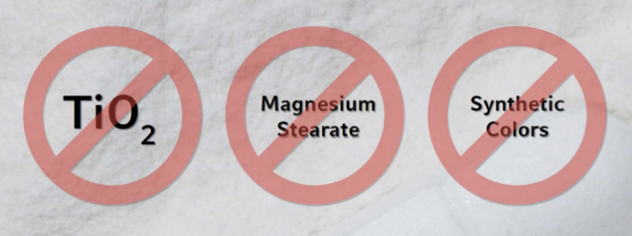In general, clean label is a consumer driven movement, demanding a return to real food and transparency through authenticity. Nutraceuticals should contain natural, familiar, simple ingredients that are easy to recognise, understand and pronounce.
Therefore, the industry has to look for new excipients & ingredients. No artificial ingredients or synthetic chemicals are in demand for a consumer-friendly labelling. Always remember: Consumers & customers paying attention to the list of ingredients & are good informed.
There are a few accepted challenges faced by the brand owner and contract manufacturing organisation (CMO) when developing such products:
- Find natural, non-GMO ingredients
- Source organic ingredients when available
- Keep products allergen/gluten-free
- Correctly manufacture products without traditional manufacturing aids (excipients/non-active ingredients)
- Minimise use of additives and fillers
- Changes to regulatory requirements lead to formulation adjustments
Critical excipients currently discussed by the industry are e.g. synthetic colours, iron oxides, silicon dioxides, magnesium stearates, titanium dioxide, etc. which are used as flow agent, lubricant, binder, filler or pigment in solid oral dosage forms, for example.

Titanium dioxide (TiO2) – a critical excipient?
E171 - one of the most important food additives in Nutraceuticals, widely used as a whitening agent (e.g. in tablets or tablet film coating). It is known as the white pigment with highest refractive index and brightness. An excipient with unique properties - even a low content of titanium dioxide provides a significant influence to nutraceutical products.
But why is titanium dioxide considered as critical? Several current studies describe a potential risk of TiO2 nanoparticles to the human respiratory system. So remember that consumers and customers paying attention to the list of ingredients and are good informed. And the logical conclusion would be that consumers who find a questionable ingredient on the ingredient list will not buy the product in the worst case.
Challenges for TiO2 free film coatings – formulation change, an example
Film coating users & manufacturers have to face several challenges by developing TiO2 free film coating formulations. Alternative raw materials require a higher content in a formulation compared to TiO2 – there are only limited possibilities due to necessary amounts of functional excipients.
- Ensuring of comparable film-coating functions and film-coating properties like TiO2 containing formulations.
- Decisive film-coating properties for TiO2 free film coatings: brightness & opacity
- Ensuring a similar preparation and application of TiO2 free film coatings
There are several possible replacements for titanium dioxide e.g. carbonates, phosphates, starches.
In a case study, BIOGRUND investigated possible substitutes for titanium dioxide in film coating systems. Twelve formulations containing five different replacements for TiO2 with different particle sizes in a standard film-coating formulation were investigated. The core formulation existed of different vitamins, widely used in nutritionals. A standardized film-coating process in a fully perforated drum was performed as well as a comparison of different weight gain levels.
Investigated film-coating properties were opacity, brightness, film flexibility, strength and surface and viscosity.

The results of all coating trials showed, that only a mixture out of several replacements can replace TiO2 in the coating formulation for combining its properties. Also using a higher weight gain level for increasing the properties of the replacements is recommended.
In conclusion, there are suitable replacements for titanium dioxide in film coatings and thus also for clean label. The mixture of different replacements can combine several raw-material properties for getting a comparable TiO2 free film coating.
For more information about the study contact info@biogrund.com Author: Rüdiger Dartsch, BIOGRUND GmbH




